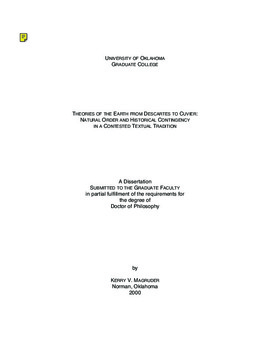| dc.contributor.advisor | Taylor, Kenneth L., | en_US |
| dc.contributor.author | Magruder, Kerry V. | en_US |
| dc.date.accessioned | 2013-08-16T12:30:59Z | |
| dc.date.available | 2013-08-16T12:30:59Z | |
| dc.date.issued | 2000 | en_US |
| dc.identifier.uri | https://hdl.handle.net/11244/6004 | |
| dc.description.abstract | Parts I and II together suggest that the language of biblical idiom fostered the expression of historical sensibilities in the tradition, although such idiom was never an essential characteristic of Theories of the Earth. Hexameral idiom facilitated the interpretation of Earth history as an ordered succession of events (prehuman, sometimes historically-contingent, not necessarily ancient) on the basis of the coordinated reading of a variety of kinds of empirical evidence. This supports a modest form of Roger's Relevance Thesis, consistent with other studies emphasizing the significance of historical scholarship, mineralogy, and paleontology for the development of historical sensibilities. | en_US |
| dc.description.abstract | Part I explores the character of Theories of the Earth as a contested textual tradition. A textual tradition is delineated by internal and external textual criteria rather than defined as a mentality or metaphysical world-view. As a textual tradition Theories of the Earth were contingently established with Descartes and the controversies over Burnet and sustained through the generation of Cuvier, rather than being the inexorable expression of post-Copernican cosmology, of a metaphysical world-view, or of a pre-geological genre of non-empirical speculation. Theories of the Earth were a contested textual tradition in which experts representing diverse technical traditions participated rather than a unified, conceptually-continuous, intrinsically-coherent research program. | en_US |
| dc.description.abstract | Part II sketches a rough portrait of Theories of the Earth based upon a "reading" of their visual representations of the globe. Chapter 4 argues that in addition to being of interest in their own right, global illustrations provide a suitable subject for analysis in the terms of textual traditions. At the same time they serve as a more representative sample of what Theories of the Earth were about than would a survey of alleged key concepts. Chapter 5 provides a systematic reading of the illustrations involved in the establishment of the contested textual tradition. Chapter 6 surveys snapshots of various technical transformations of the tradition. | en_US |
| dc.description.abstract | Jacques Roger argued that Theories of the Earth contributed to the development of historical sensibilities in natural science. This dissertation establishes the need to positively reassess a modest form of his "Relevance Thesis." | en_US |
| dc.format.extent | 4 pts. (xxvi, 871 leaves) : | en_US |
| dc.subject | Cosmology. | en_US |
| dc.subject | Cuvier, Georges, baron, 1769-1832. | en_US |
| dc.subject | Geology History. | en_US |
| dc.subject | Descartes, RenÔΩ̜, 1596-1650. | en_US |
| dc.subject | History of Science. | en_US |
| dc.title | Theories of the Earth from Descartes to Cuvier: Natural order and historical contingency in a contested textual tradition. | en_US |
| dc.type | Thesis | en_US |
| dc.thesis.degree | Ph.D. | en_US |
| dc.thesis.degreeDiscipline | Department of History of Science | en_US |
| dc.note | Adviser: Kenneth L. Taylor. | en_US |
| dc.note | Source: Dissertation Abstracts International, Volume: 61-06, Section: A, page: 2441. | en_US |
| ou.identifier | (UMI)AAI9977946 | en_US |
| ou.group | College of Arts and Sciences::Department of History of Science | |

